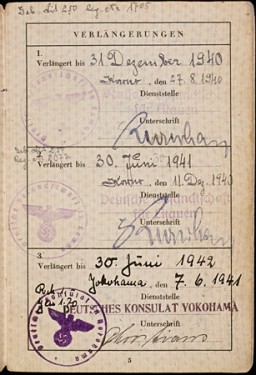
Document
Browse an alphabetical list of documents from the Holocaust and World War II. These typed, handwritten, and artistic records are evidence of human experiences before, during, and after the Holocaust and war.
<< Previous | Displaying results 1-50 of 85 for "Document" | Next >>
-
A chart detailing physical characteristics of a Romani (Gypsy) individual
DocumentA chart detailing physical characteristics of a Romani (Gypsy) individual, c. 1938. Dr. Robert Ritter and his team created extensive family trees and genealogical charts in order to identify, register, and classify all Romani people living in Nazi Germany. During the Nazi era, Dr. Robert Ritter was a leading authority on the racial classification of people pejoratively labeled “Zigeuner” (“Gypsies”). Ritter’s research was in a field called eugenics, or what the Nazis called “racial…
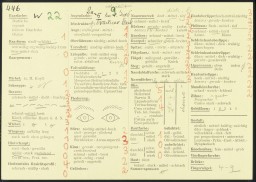
-
A genealogical chart of the Franz family
DocumentA genealogical chart of the Franz family, composed of identification photographs taken by the criminal department of the Aschaffenburg Identification Service [Erkennungsdienst]. Bavaria, Germany, 1942. This particular Romani family tree includes notes labeling individuals as "vagrants," "invalids," or "habitual criminals." Racial hygienists would collect genealogical documents or create family trees in order to identify, register, and classify all Romani people living in Nazi Germany. Roma (pejoratively…
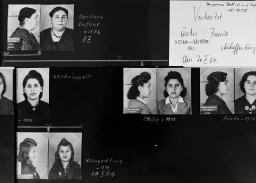
-
A notice sent by the American Consulate General in Berlin regarding immigration visas
DocumentA notice sent by the American Consulate General in Berlin to Arthur Lewy and family, instructing them to report to the consulate on July 26, 1939, with all the required documents, in order to receive their American visas. German Jews attempting to immigrate to the United States in the late 1930s faced overwhelming bureaucratic hurdles. It was difficult to get the necessary papers to leave Germany, and US immigration visas were difficult to obtain. The process could take years.

-
Advertisement for the Violetta women's club
DocumentA newspaper advertisement for the Damenklub Violetta, a Berlin club frequented by lesbians, 1928. Before the Nazis came to power in 1933, lesbian communities and networks flourished in Germany.

-
American propaganda announcement
DocumentAnnouncement dropped by American planes on Shanghai near the end of the war. [From the USHMM special exhibition Flight and Rescue.]
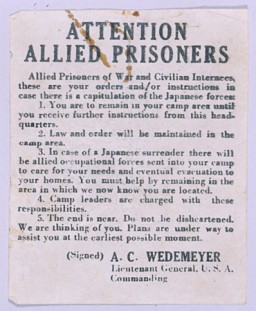
-
Anti-Nazi Cartoon
DocumentThis cartoon, “The Modern Mercury” by Jerry Doyle, appeared in The Philadelphia Record, December 7, 1935. The faded large figure in the background bears the label “Olympics ideals of sportsmanship and international good will.” The image of Hitler in the foreground bears the words “1936 Olympics,” “Intolerance and discrimination,” and “Nazism.”
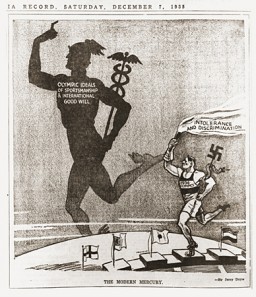
-
Antisemitic cartoon
DocumentAntisemitic cartoon showing a Jew leading a Soviet official by a leash. It reads "The 'ideal' person for the chosen people: There’s no accounting for taste."
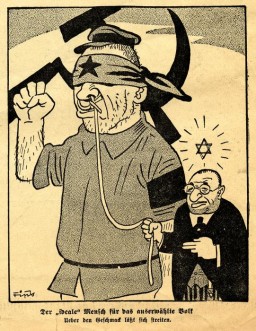
-
Antisemitic illustration
DocumentAntisemitic propaganda of an agricultural worker kicking a stereotypically depicted Jewish man through a fence. It reads "German export: Out of our German country with the slimy Jewish band."

-
Cartoon depicting enemies of the Nazis
DocumentCartoon depicting Jews, communists, and other enemies of the Nazis hanging on a gallows, 1935
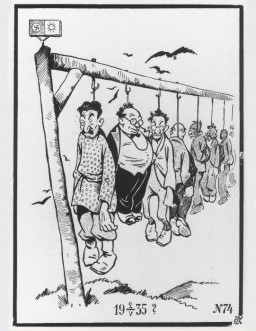
-
Census Card
DocumentOn December 17, 1941, the Romanian government issued a decree requiring a census of all those with "Jewish blood.” All persons having one or two Jewish parents or two Jewish grandparents were ordered to register at the Central Jewish Office. This is a census certificate issued by that office in 1942.
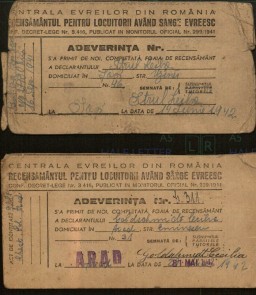
-
Census Card
DocumentOn December 17, 1941, the Romanian government issued a decree requiring a census of all those with “Jewish blood.” All persons having one or two Jewish parents or two Jewish grandparents were ordered to register at the Central Jewish Office. This is a census certificate issued by that office in 1942.
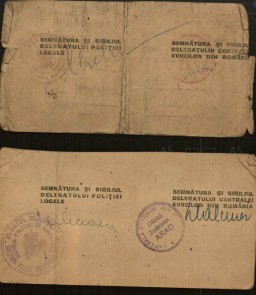
-
Certificate of "Aryan" Descent
DocumentA certificate of "Aryan" descent, issued to Joseph Schäfer of Mühlheim, Germany. To prove one's "Aryan" racial status in Nazi Germany, an individual had to trace their ancestry back to 1800. Signed by an official justice of the peace, this certificate attests to Schäfer's parentage and baptism. Dated January 14, 1936.

-
Certificate of Polish citizenship (inside)
DocumentMany refugees had difficulties replacing lost or invalidated personal identification documents. The certificate of Polish citizenship shown here was valid in place of a passport. A Polish Jewish refugee used this certificate to travel legally from Lithuania, through the Soviet Union, to Japan. It contains the Curacao notation needed to obtain Soviet and Japanese visas. The bearer of this certificate aimed to reach Palestine, but ended up spending most of the war in Calcutta, India, part of the British…
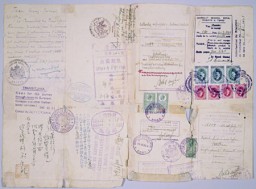
-
Diagram of the “Gypsy camp” in Hodonín u Kunštátu
DocumentDiagram of the Hodonín u Kunštátu (Hodonin bei Kunstadt) camp in the Protectorate of Bohemia and Moravia (Czech Republic). Before it was converted into a Zigeunerlager (“Gypsy camp”) in 1942, it served as a penal labor camp. Translation of key: Scale 1:500 Sleeping quarters Sleeping quarters Mess-hall Infirmary Offices, prison Living quarters for guard staff Economic/Agricultural Building Latrine Well Mess-hall for guard staff Pens for guard dogs
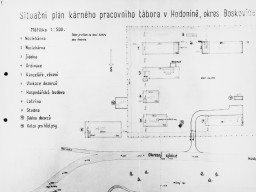
-
Dismissal letter
DocumentDuring the interwar period Dr. Susanne Engelmann served as the principal of a large public high school for girls in Berlin. This letter notified her of her dismissal, as a "non-Aryan," from her teaching position. The dismissal was in compliance with the Civil Service Law of April 7, 1933. On April 7, the German government issued the Law for the Restoration of the Professional Civil Service (Gesetz zur Wiederherstellung des Berufsbeamtentums), which excluded Jews and political opponents from all civil…
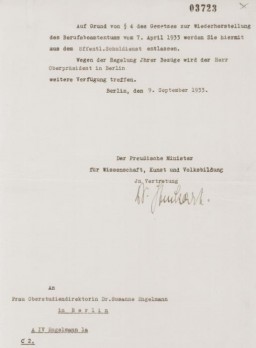
-
Dismissal letter from the Berlin transit authority
DocumentA letter written by the Berlin transit authority (Berliner Verkehrs Aktiengesellschaft) to Viktor Stern, informing him of his dismissal from his post with their agency as of September 20, 1933. This action was taken to comply with provisions of the Law for the Restoration of the Professional Civil Service. On April 7, the German government issued the Law for the Restoration of the Professional Civil Service (Gesetz zur Wiederherstellung des Berufsbeamtentums), which excluded Jews and political opponents…

-
Document Belonging to Chief Prosecutor Benjamin Ferencz
DocumentOne page of a document belonging to Chief Prosecutor Benjamin Ferencz listing the defendants in the Einsatzgruppen Case along with their position and crimes, line of defense, counts against them, and sentence.
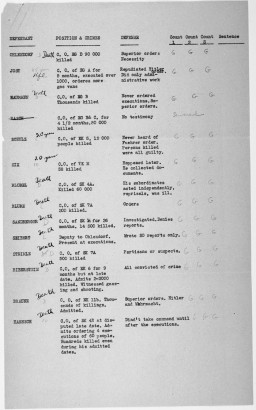
-
Documentation for a false identity: Simone Weil
DocumentSimone Weil kept this blank identification card bearing her picture in case her cover as "Simone Werlin" were blown and she needed to establish a new false identity. Both resistance workers and sympathetic government employees provided her the necessary stamps and signatures. Such forged documents assisted Weil in her work rescuing Jewish children as a member of the relief and rescue organization Oeuvre de Secours aux Enfants (Children's Aid Society; OSE).
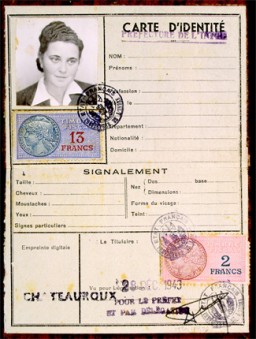
-
Aaron A. Eiferman Letter: Page 1
DocumentFirst page of a letter from a US soldier describing "the living dead" and conditions his unit encountered in a subcamp of Dachau in April 1945.
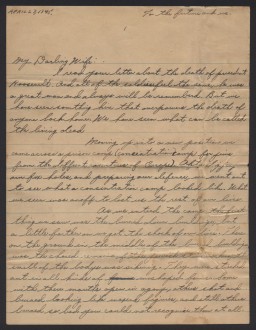
-
False identity for Kurt I. Lewin
DocumentKurt I. Lewin, who was Jewish, used this card while in hiding in a Ukrainian Greek Catholic monastery in German-occupied Poland (today Ukraine).
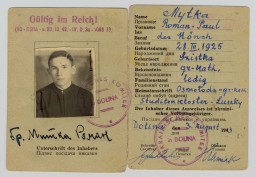
-
False identity for Żegota member Ewa Sarnecka
DocumentDuring World War II, people often used false identities and forged identity documents to evade Nazi authorities. False identities were essential for resistance fighters, aid workers, and Jews hoping to pass as non-Jews. Creating high-quality, convincing forgeries required dozens of people to work together clandestinely. It also required sophisticated photography and printing equipment. For Jews passing as non-Jews, acquiring forged documents could mean the difference between life and death. During World…
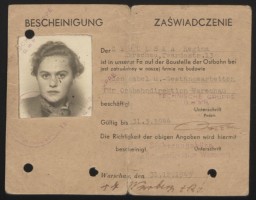
-
False identity for Żegota member Izabela Bieżuńska
DocumentDuring World War II, people often used false identities and forged identity documents to evade Nazi authorities. False identities were essential for resistance fighters, aid workers, and Jews hoping to pass as non-Jews. Creating high-quality, convincing forgeries required dozens of people to work together clandestinely. It also required sophisticated photography and printing equipment. For Jews passing as non-Jews, acquiring forged documents could mean the difference between life and death. This…
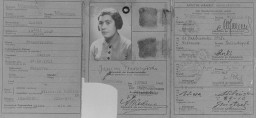
-
False identity for Żegota member Tadeusz Sarnecki
DocumentDuring World War II, people often used false identities and forged identity documents to evade Nazi authorities. False identities were essential for resistance fighters, aid workers, and Jews hoping to pass as non-Jews. Creating high-quality, convincing forgeries required dozens of people to work together clandestinely. It also required sophisticated photography and printing equipment. For Jews passing as non-Jews, acquiring forged documents could mean the difference between life and death. This forged…

-
German Map of the Baltic Countries
DocumentThis German map indicates the number and distribution of Jews living in the Baltic countries as of 1935. It served as a reference for the SS mobile killing squad assigned to carry out the mass murder of the Jews there.
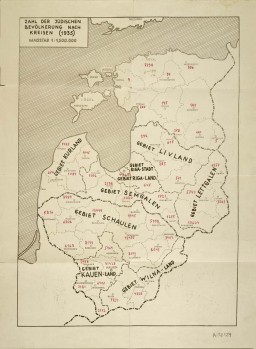
-
German passport issued to Alice "Sara" Mayer (inside)
DocumentA German passport issued to Alice Mayer on February 24, 1939, in Bingen, Germany. Mayer's daughter, Ellen, is also listed on the passport. Both mother and daughter's names include the middle name "Sara." This middle name became a mandatory addition required by a law of August 17, 1938. Thereafter, all Jewish women in Germany with a first name of "non-Jewish" origin had to add "Sara" as a middle name on all official documents. Jewish men had to add the name "Israel". This enabled German officials to…

-
German passport Issued to Erna "Sara" Schlesinger (inside)
DocumentGerman police authorities issued this passport to Erna "Sara" Schlesinger on July 8, 1939, in Berlin. This first page of the passport illustrates the German laws that facilitated the identification of Jews in Germany. From 1938, German regulations required that Jewish women with a first name of "non-Jewish" origin use the middle name "Sara" on all official documents. Jewish men had to add the name "Israel". The letter "J" (standing for "Jude," that is, the word "Jew" in German) was stamped in red on the…

-
Hand-drawn plan of Westerbork transit camp
DocumentThe Dutch government established a camp at Westerbork to intern Jewish refugees who had entered the Netherlands illegally. This sketch of the Westerbork transit camp was made by a Jewish inmate who was able to emigrate to the United States. In early 1942, the German occupation authorities decided to enlarge Westerbork and convert it into a transit camp for Jews. The systematic concentration of Jews from the Netherlands in Westerbork began in July 1942. From Westerbork, Jews were deported to the killing…
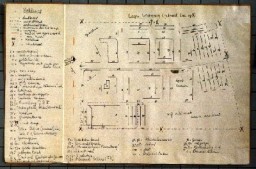
-
Identification papers issued to Erika Tamar
DocumentIdentification papers issued to Erika Tamar stating that she was born in Vienna on June 10, 1934. Erika was one of the 50 children rescued by Gilbert and Eleanor Kraus.

-
Ilona Kellner's recipe for butter scones with jam
DocumentIlona Kellner and her family lived in Pelsöc, which became part of Hungary before World War II. Following the German occupation of Hungary, Ilona, her sister Vera, and her parents Karoly and Jolan were forced into a ghetto in another area of the town. In mid-June, the family was deported to the Auschwitz camp in German-occupied Poland. Ilona's parents were killed in the gas chambers at Birkenau. In early August, Ilona and her sister were deported to Hessisch Lichtenau, a subcamp of the Buchenwald…
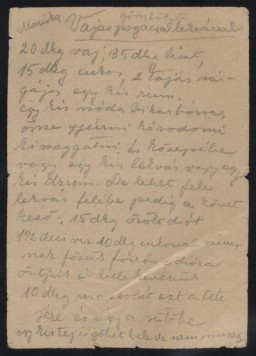
-
Ilona Kellner's recipe for various strudel fillings
DocumentIlona Kellner and her family lived in Pelsöc, which became part of Hungary before World War II. Following the German occupation of Hungary, Ilona, her sister Vera, and her parents Karoly and Jolan were forced into a ghetto in another area of the town. In mid-June, the family was deported to the Auschwitz camp in German-occupied Poland. Ilona's parents were killed in the gas chambers at Birkenau. In early August, Ilona and her sister were deported to Hessisch Lichtenau, a subcamp of…
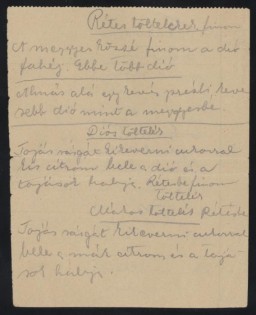
-
Intourist service voucher for the Trans-Siberian Railroad
DocumentVoucher for travel on the Trans-Siberian Railroad purchased at the "Intourist Travel Company of the USSR" in England for Joseph and Ruth Schaffer. Thousands of Jewish refugees fled Nazi Europe on the Trans-Siberian Railroad through the Soviet Union to Japan with the help of Japanese visas provided by Japanese diplomat Chiune Sugihara. [From the USHMM special exhibition Flight and Rescue.]
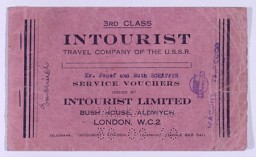
-
Letter from Esther Lurie regarding lost art, 1945
DocumentThis document is one page of a letter from artist Esther Lurie, written after the war, asking for help in following down leads and locating the artwork she had created and hidden while imprisoned in the Kovno ghetto, Lithuania. She wrote, "The matter concerns a collection of 200 pen-and-ink drawings representing scenes of ghetto life which I made during my internment in the Kaunas Ghetto (Lithuania) in 1941-1944. I left the drawings buried in the earth as I felt that I had no hope of survival."

-
Letter home from an American soldier about the end of World War II in Europe
DocumentRudolph Daniel Sichel (b. 1915) left Germany in 1934 for England and then immigrated to the United States in 1936. His father, who had remained in Germany, was arrested during Kristallnacht, sent to Buchenwald for a couple of months, forced to sell his store at a loss, and immigrated to the United States with Rudolph's mother shortly after. Sichel joined the US Army in 1943, attending courses at the Military Intelligence Training Center at Camp Ritchie, MD. He landed on Utah Beach in July 1944 and was…
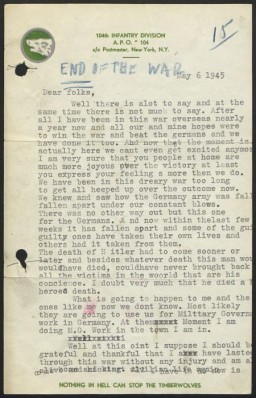
-
Listing of Jews for deportation to Riga, Latvia
DocumentThe SS compiled lists of Jews who were to be deported to ghettos, concentration camps, and killing centers. This document provides the names, birthdates, marital status, and addresses of Jews who were “evacuated” on November 20, 1941 from Germany to the Riga ghetto in German-occupied Latvia.
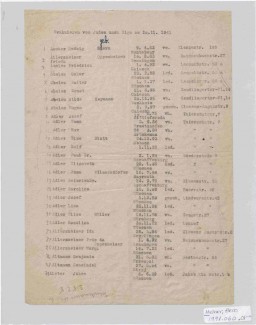
-
Lithuanian safe conduct pass (reverse)
DocumentA Lithuanian safe conduct pass bearing a stamp for transit through Japan (from Chiune Sugihara), two Soviet transit visas, a Lithuanian stamp, a U.S. non-immigrant visa, and a U.S. entry stamp from Seattle, Washington. [From the USHMM special exhibition Flight and Rescue.]

-
Magdalena Kusserow's letter to her sister
DocumentMagdalena Kusserow, incarcerated in a special barracks for Jehovah's Witnesses in the Ravensbrück concentration camp, used stationery provided to prisoners to write a letter to her sister Annemarie in April 1942. The handwritten numbers in the block in the upper right identify Magdalena as prisoner 9591, assigned to block 17a. Magdalena wrote to her sister in part (translated from German): "Dear Annemarie. Received your letter of March 15, did you get mine? I'm fine. How did it go with Wolfgang's 2nd…
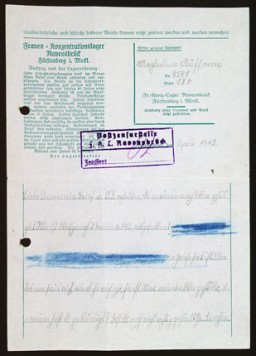
-
Mariska's recipe for hazelnut cake
DocumentIlona Kellner and her family lived in Pelsöc, which became part of Hungary before World War II. Following the German occupation of Hungary, Ilona, her sister Vera, and her parents Karoly and Jolan were forced into a ghetto in another area of the town. In mid-June, the family was deported to the Auschwitz camp in German-occupied Poland. Ilona's parents were killed in the gas chambers at Birkenau. In early August, Ilona and her sister were deported to Hessisch Lichtenau, a subcamp of the Buchenwald…
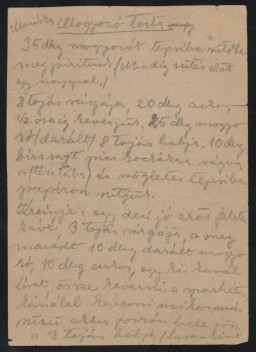
-
Marriage certificate obtained by Dr. Mohamed Helmy
DocumentMarriage certificate obtained by Dr. Mohamed Helmy stating that Anna Gutman (Boros) married an Egyptian man in a ceremony held in Helmy’s home. Dr. Helmy also received certification from the Central Islamic Institute in Berlin attesting to Anna’s conversion to Islam, which the marriage certificate reflects. Translation: Marriage certificate On Wednesday June 16, 1943, we have certified the marriage contract between Abdelaziz Helmy Hammad, 36 years old, who was born on May 6th, 1906, in Faqous,…

-
Max Diamant's identity card (inside)
DocumentMax Diamant obtained this identity card from the German health department located in Krakow (Krakau), occupied Poland, in July 1942. This view shows the interior pages, which identify him as a Jew and detail his personal information, such as occupation (dental assistant), birthdate (June 23, 1915), birthplace (Vienna), and current address in Przemysl, Poland.

-
Max Diamant's identity card (outside)
DocumentIn July 1942, the German health department located in Krakow (Krakau), occupied Poland, issued this identity card to Max Diamant. This view shows the front and back covers of the card. The interior pages identify Diamant as a dental assistant in Przemysl, Poland, and show his signature and photograph mounted under the stamped word "Jew."

-
Mrs. Zinger's recipe for mocha cake
DocumentIlona Kellner and her family lived in Pelsöc, which became part of Hungary before World War II. Following the German occupation of Hungary, Ilona, her sister Vera, and her parents Karoly and Jolan were forced into a ghetto in another area of the town. In mid-June, the family was deported to the Auschwitz camp in German-occupied Poland. Ilona's parents were killed in the gas chambers at Birkenau. In early August, Ilona and her sister were deported to Hessisch Lichtenau, a subcamp of the Buchenwald…
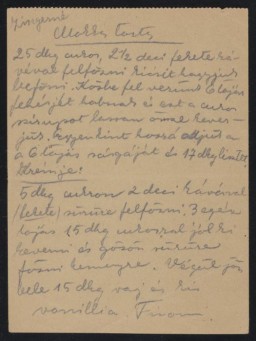
-
Newspaper article "The Refugee Tragedy"
DocumentSan Francisco Chronicle newspaper article titled "The Refugee Tragedy." The article was based on an interview with Moses Beckelman of the American Jewish Joint Distribution Committee, an aid organization. It discussed the overcrowding of Polish and Lithuanian refugees stranded in Shanghai, Kobe (Japan), and Lisbon (Portugal), all stops en route to North and South America. The primary cause of this bottleneck was a lack of transit and entry visas, a result of most countries closing their borders to…

-
Notice of Gregor Wohlfahrt's execution
DocumentAuthorities in Berlin, Germany, sent this notice to Barbara Wohlfahrt, informing her of her husband Gregor's execution on the morning of December 7, 1939. Although he was physically unfit to serve in the armed forces, the Nazis tried Wohlfahrt for his religious opposition to military service. As a Jehovah's Witness, Wohlfahrt believed that military service violated the biblical commandment not to kill. On November 8, 1939, a military court condemned Wohlfahrt to beheading, a sentence carried out one month…

-
On the waiting list for American visas
DocumentThis document from the American Consul-General in Vienna certifies that the Trost family applied for American visas on September 15, 1938. It states that the family (Josef, Alice, Dorrit, and Erika) were placed on the waiting list for visas with the numbers 47291-47294.
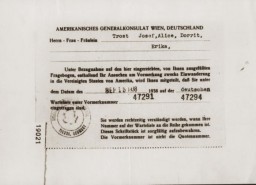
-
On the waiting list for American visas
DocumentSelmar and Elsa Biener joined the waiting list for US immigration visas in September 1938. Their waiting list numbers—45,685 and 45,686—indicate the number of people who had registered with the US consulate in Berlin. By September 1938, approximately 220,000 people throughout Germany, mostly Jews, were on the waiting list.
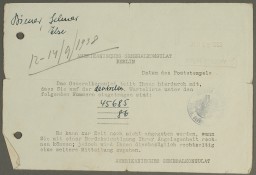
-
Our Life newspaper: Allied victory
DocumentNewspaper Our Life, for September 7, 1945, showing the headline "Long Live Allied Victory". [From the USHMM special exhibition Flight and Rescue.]
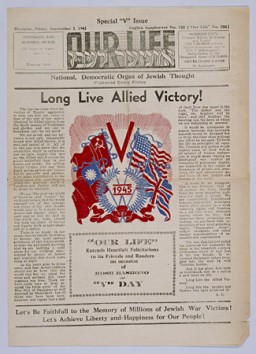
-
Page 12 of passport issued to Setty Sondheimer
DocumentTransit visa in a passport issued to Setty Sondheimer, a German citizen. This visa, issued on August 6, 1940, enabled her to travel through Japan en route to Surinam, Curacao, or other Dutch colonies in the Americas. These plans were disrupted when travel across the Pacific Ocean was forbidden following U.S. entry into World War II. Setty remained in Japan until she was able to emigrate to the United States in 1947. [From the USHMM special exhibition Flight and Rescue.]

-
Page 17 of passport issued to Setty Sondheimer
DocumentA page in a passport belonging to Setty Sondheimer containing stamps from Ecuador. These stamps are marked in red with the word "Anulado," the Spanish word for "canceled." The stamps were canceled when Setty's visa for Ecuador expired because she was unable to travel across the Pacific due to fighting in that theater. Setty remained in Japan for the duration of the war and emigrated to the United States in 1947. [From the USHMM special exhibition Flight and Rescue.]
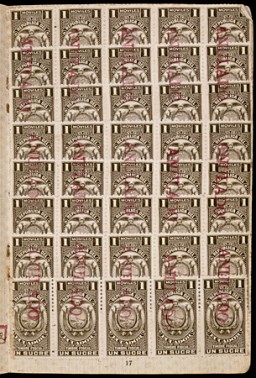
-
Page 2 of passport issued to Setty Sondheimer
DocumentSetty and Moritz Sondheimer and their two children fled Nazi Germany for Kovno, Lithuania, in 1934. There, Moritz opened a small factory manufacturing buttons and combs. This image shows page 2, containing an identification photograph, of a passport issued to Setty Sondheimer by the German Consulate in Kovno on January 29, 1938. With aid from Japanese diplomat Chiune Sugihara in obtaining Japanese transit visas, Setty and her family emigrated from Kovno in February 1941. [From the USHMM special exhibition…
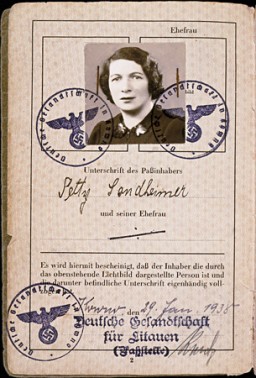
-
Page 5 of passport issued to Setty Sondheimer
DocumentPage 5 of a passport issued to Setty Sondheimer by the German Consulate in Kovno on January 29, 1938. This page contains three visas: (1) visa for Kovno valid from August 27, 1940, until December 31, 1940 (2) a second visa for Kovno valid until June 30, 1941, and (3) first visa for Yokohama, Japan, valid from June 7, 1941, until June 30, 1942. Unable to emigrate from Japan, Setty remained there until she was able to emigrate to the United States in 1947. [From the USHMM special exhibition Flight and…
